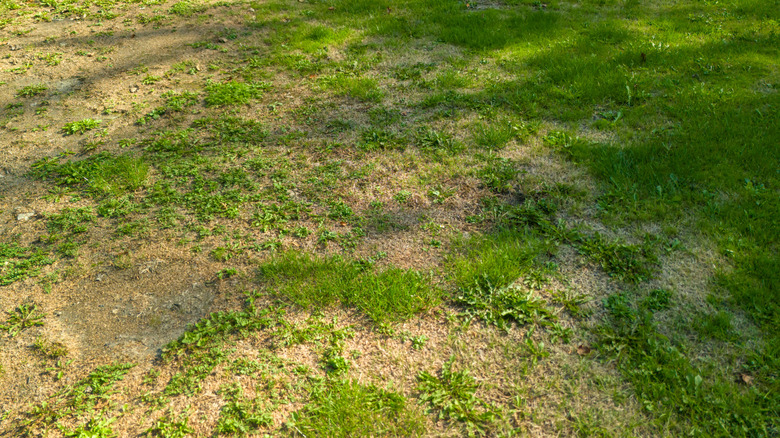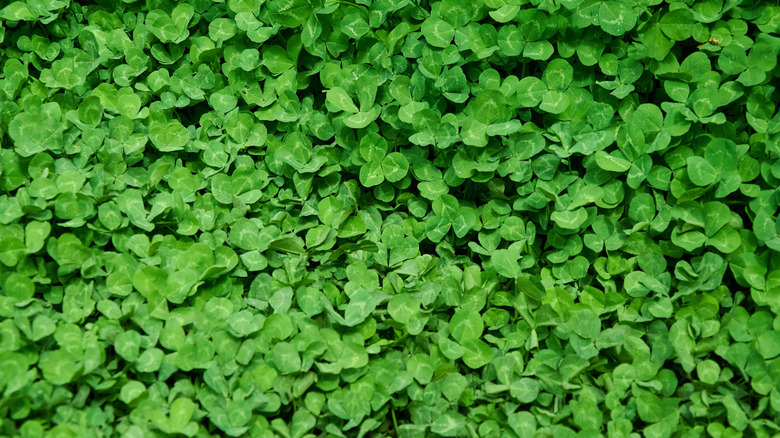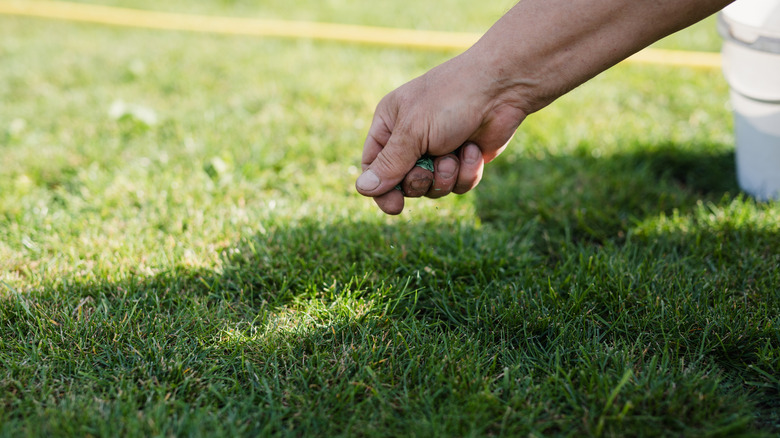The Easy Grass Alternative To Fix Patchy Spots In Your Lawn
Few things are as frustrating as finding bare patches or brown spots in an otherwise pristine lawn — at least for homeowners who want a lush, green yard. Unfortunately, grass lawns can be fussy and require diligent maintenance to combat the weeds, insects, diseases, and other problems that can spell their doom. But if you're tired of stressing over the amount of water, sunlight, fertilizer, and mowing your lawn requires, it may be time to consider clover for filling in the ugly patches in your grass.
Like other eco-friendly grass alternatives, clover is a low-maintenance ground cover option. Its reduced maintenance needs certainly make it a kinder choice for the environment, but they also mean that it's easier to keep green. The most commonly used varieties of clover in lawns are white clover (Trifolium repens) and Micro-clover (Trifolium repens var. Pipolina). White clover typically grows between 4 and 8 inches, but micro-clover can be mowed shorter and doesn't flower as much, making it a better choice for areas with heavier foot traffic. Micro-clover blends particularly well with turfgrass, too, making it ideal for filling in patchy lawns.
Why clover is an excellent grass alternative
The main appeal of a clover lawn for most homeowners is its ability to thrive with little maintenance. It is extremely drought-resistant and can stay green even in hot, dry weather. It also grows well in most types of soil with a pH between 6 and 7 and doesn't require full sun or drainage, unlike grass, which typically does. It never needs to be fertilized, either, because it naturally converts nitrogen into organic material that feeds the soil. Best of all, it requires very little mowing because it doesn't grow very high, allowing it to look neat without constant trimming. Its sturdy root system helps keep weeds at bay, too.
A break from mowing and weeding may be enough to sell you on clover as a grass alternative, but it has even more benefits for your yard. While it is resistant to most garden pests, it attracts pollinators, including bees and butterflies, which helps the other plants and flowers in your yard grow. If you have pets, you'll also appreciate how resistant it is to dog urine, which makes those unsightly yellow spots on your grass lawn a thing of the past.
How to fill in a patchy lawn with clover
The best time to plant clover is in mild weather when the temperature is above 40 degrees. In most areas, springtime planting between April and June is ideal, but you can also plant in early fall, provided the seeds are planted before October. When filling in a patchy lawn with clover, it's important to mow the existing grass short, trimming it to 1 to 1½ inches tall. Rake the area to remove any leaves, roots, stems, or other thatched materials and ensure the soil isn't compacted. This allows the seeds to have better contact with the soil, helping the clover grow evenly.
Next, mix the seeds with sawdust or dry sand to make the clover easier to spread and provide better coverage. Broadcast the seeds over the patchy areas in your lawn, and then use the backside of the rake to gently press them into the soil. Water the area after planting, making sure the soil is thoroughly moistened without disturbing the seeds. The soil should remain moist for 14 days or until the clover has germinated, which may require watering it two to three times a day. Avoid mowing the area for at least three weeks to ensure the clover is fully established.


